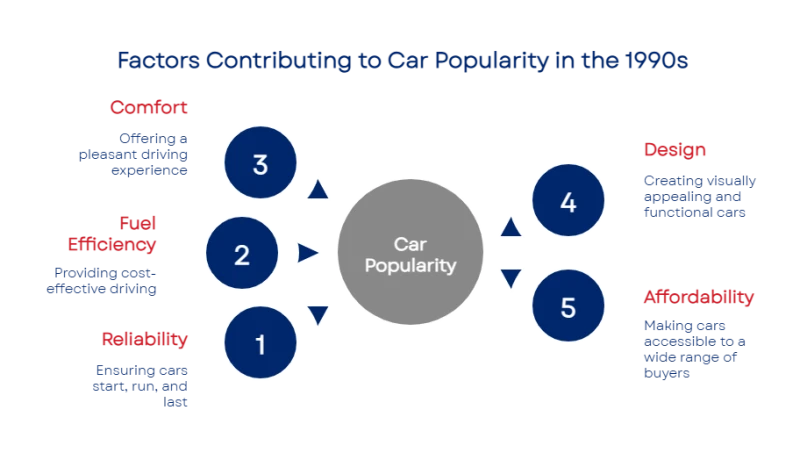The 1990s reshaped the auto industry. This was the decade when cars became smarter, faster, and more reliable without losing their soul.
Japanese brands gained global respect. Honda’s NSX proved a supercar could be both fast and usable. Toyota’s Supra packed twin turbos and iconic tuning potential. Nissan’s 300ZX stayed on Car and Driver’s 10 Best list for seven years.
In the U.S., Ford’s Mustang and Cobra SVT gave performance buyers something to cheer about. The Impala SS brought Corvette power to a full-size sedan. Even pickups like the GMC Syclone shocked the market, beating a Ferrari to 60 mph in 4.3 seconds.
Meanwhile, Europe stayed bold. BMW’s M3 set the sport sedan standard. Mercedes-Benz built the 500E with help from Porsche. Ferrari and Porsche focused on refinement without giving up raw power.
These brands didn’t just chase speed. They created performance cars, daily drivers, and SUVs that met real-world needs while staying fun to drive.
What You’ll Learn in This Article
Which 1990s car brands made the biggest cultural impact
The most popular cars of the 1990s and why they ruled the roads
Which 1990s car brands are making a comeback
Overview
Here's a more detailed breakdown:
American Muscle & Reinvention
American brands adapted to international competition by modernizing classic models and introducing new performance lines to meet a wide range of buyer needs.
European Prestige & Performance
European manufacturers focused on precise engineering and high-end performance, shaping luxury and driving feel with balanced power and refined design.
Japanese Everyday Leaders
Japanese automakers emphasized reliability, efficiency, and long-term value, dominating global markets with practical and durable cars.
Comeback Brands
Certain 1990s brands have seen renewed interest, either through continued success or the revival of classic models, appealing to collectors and drivers seeking a nostalgic feel.
Other Notable Aspects
Average Car Cost: The average new car cost in the United States in 1990 was around $16,000, reflecting the pricing landscape of that era.
Collectibility: Many 1990s performance and low-mileage cars are increasing in value among collectors and enthusiasts due to their unique attributes.
American Muscle & Reinvention
In the 1990s, American car companies had something to prove. Competition from Japan was rising fast, and European luxury brands were setting the pace in design and performance. But U.S. automakers didn’t step back; they adapted. They modernized older models, launched special performance lines, and built new vehicles that connected with car buyers across a range of needs from raw horsepower to interior room.
Ford: Legacy Muscle Meets Street Performance
Ford’s identity was rooted in working-class power, and the 90s were no exception. The Ford Mustang remained one of the brand’s biggest sellers, thanks to its strong mix of price, performance, and nostalgia. While still rear wheel drive, the Mustang got more refined during the decade, with better suspension, more power, and tighter handling.
Mustang GT: By 1996, the GT was running a 4.6L modular V8 that delivered 215 hp and 285 lb-ft of torque: reliable, affordable power for everyday drivers.
SVT Cobra: The SVT division, launched in the early 90s, gave Ford a high-performance edge. The Cobra variant pushed into the 300 hp range by 1996 and became a favorite among American performance fans.
Escort RS Cosworth (Euro market): Though never sold in the U.S., this AWD rally-inspired model earned cult status with a turbocharged engine and unmistakable rear spoiler.
Ford also saw continued success with sedans like the Taurus, including the SHO (Super High Output) edition, which featured Yamaha-developed V6 engines and high-rev performance in an otherwise standard-looking family car.
Chevrolet: Classic Muscle, Repackaged
Chevrolet leaned on what it did best (build cars with muscle) and updated its platforms with better tech, handling, and value. The brand had a strong decade across multiple segments.
Camaro Z28: Refreshed in 1993, the Z28 came with a 5.7L LT1 engine producing 275 hp. Its aggressive styling and strong price-to-performance ratio made it a staple in the American performance market.
Corvette C4 & ZR-1: The fourth-generation Corvette kept improving, but the highlight was the ZR-1. With its Lotus-designed 5.7L V8 and 375 hp, it was the fastest American car of its time.
Impala SS (1994–1996): A full-size sedan powered by the same LT1 engine used in the Corvette. It produced 260 hp and 330 lb-ft of torque and appealed to buyers who wanted room and power in the same package.
Chevy also stayed strong in the truck and SUV markets, setting up for the explosive growth those segments would see in the 2000s.
GMC: Performance Where You Least Expected
GMC wasn’t known for speed until the early '90s, when it shocked the market with two high-performance models.
GMC Syclone (1991): A compact pickup with a turbocharged 4.3L V6, all-wheel drive, and 0–60 mph in just 4.3 seconds. It outpaced a Ferrari 348 in tests. Only around 3,000 were produced, making it one of the rarest performance vehicles of the decade.
GMC Typhoon (1992–1993): An SUV using the same powertrain as the Syclone, built on the Jimmy platform. It offered Corvette-like speed with SUV practicality.
These two models were short-lived but helped GMC carve a unique identity and gain respect among enthusiasts.
Dodge / Chrysler: Big Moves and Bold Power
Dodge, under Chrysler’s umbrella, took some of the biggest risks of the '90s, and they paid off.
Dodge Viper RT/10 (1992): Launched with an 8.0L V10 engine producing 400 hp and 465 lb-ft of torque, the Viper was brutal and raw. It had no ABS, no traction control, and barely had windows. But it was fast: 0 to 60 mph in under 5 seconds, and instantly iconic.
Chrysler’s LH cars such as the Intrepid and Concorde, focused on interior space and futuristic cab-forward styling. While not performance cars, they helped reposition Chrysler as a tech-forward company in the family car space.
Dodge and Chrysler took different routes, one built muscle, the other leaned into design and comfort, but together they showed that bold ideas still had a place in the American market.
European Prestige & Performance
In the 1990s, European car brands focused on precision, balance, and high-end performance. They weren’t chasing flash. They were building some of the best-engineered vehicles in the world. From BMW’s perfectly tuned sedans to Ferrari’s screaming V8s, these brands shaped how the world defined luxury, sport, and driving feel. While their prices were often higher, their influence reached far beyond their sales numbers.
BMW: The Sport Sedan Standard
BMW used the 1990s to perfect its brand promise: a driver’s car in every model. The company’s balance of power, handling, and everyday usability helped it stand out in every market segment.
BMW M3 (E36, 1995–1999 U.S.): Often considered the best blend of performance and comfort at the time. It offered 240 hp from an inline-six engine, with tight steering and near-perfect balance. Rear-wheel drive, manual gearboxes, and clean design kept it connected to real drivers.
BMW 8 Series: A high-end grand tourer with a V12 option and sharp styling. Though expensive, it was one of the most advanced models of the decade.
BMW’s commitment to driver feel, quality materials, and engineering set a bar few others could match.
Mercedes-Benz: Quiet Power and Build Quality
Mercedes-Benz was known for its rock-solid engineering. But in the 90s, it added real power to the mix, especially with its AMG and Porsche partnerships.
500E (1990–1995): A 322-hp sleeper sedan built in partnership with Porsche. It looked like a regular E-Class but could hit 60 mph in under 6 seconds.
SL500 & SL600: Convertible grand tourers with V8 and V12 engines. Known for their smooth ride, high price, and durable build.
C36 AMG (1995): This model marked Mercedes-AMG’s entry into the compact performance market, offering 276 hp in a refined package.
Mercedes gave buyers premium performance without shouting about it. These were performance cars in suits.
Porsche: Pure, Mechanical Precision
Porsche held onto its identity while making key changes that would define the brand for decades.
911 (993, 1995–1998): The last air-cooled 911. Many consider it the best-driving model Porsche ever made. It offered clean lines, smooth power delivery, and a genuine emotional connection.
968: A front-engine sports coupe that helped round out Porsche’s lineup with a more affordable option.
By staying true to their design roots, Porsche kept enthusiasts close even as prices climbed.
Ferrari: Loud, Fast, and Exotic
Ferrari stayed focused on what it did best: build supercars that looked and sounded like nothing else.
Ferrari F355 (1994–1999): Introduced with a 3.5L V8 producing 375 hp. It could rev to 8,250 rpm and hit 60 mph in under 5 seconds.
Ferrari F50 (1995): A V12-powered supercar with F1 DNA and a removable roof. It produced 513 hp and cost over $500,000 new.
Ferrari stayed rare, expensive, and dramatic, but the ‘90s proved it could still lead the world in performance.
Volkswagen: Accessible European Engineering
While not as exotic as Ferrari or Porsche, Volkswagen played an important role for everyday drivers.
Golf GTI Mk3: Front-wheel drive, nimble, and practical. It wasn’t the fastest, but it was fun and affordable.
Corrado VR6: A sleek coupe with a narrow-angle V6 that delivered smooth power in a unique package.
VW gave drivers in the U.S. and Europe a taste of Euro handling and engineering without the high-end price tag.
Bugatti (EB110)
Though short-lived in the 90s, Bugatti’s EB110 deserves mention. Launched in 1991, it packed a 3.5L quad-turbo V12, AWD, and 553 hp, making it one of the most advanced supercars of its time. Only 139 were produced before the company folded, but its legacy shaped what Bugatti would become in the 2000s.
Japanese Everyday Leaders
Japan’s automakers didn’t just define performance in the 1990s; they shaped how everyday drivers thought about quality, price, and long-term value. These brands dominated global markets by building cars that were simple, efficient, and durable. While their sports cars grabbed headlines, it was their everyday models that moved hundreds of thousands of people and helped change the direction of the entire auto industry.
Toyota: Global Consistency and Smart Design
Toyota’s reputation for reliability solidified in the 1990s. Whether you were buying a compact, sedan, or wagon, you could count on it to start, run, and last.
Toyota Corolla: The world’s best-selling nameplate during the decade. Compact, fuel-efficient, and offered with a range of trims, the Corolla was easy to maintain and fit for nearly every type of driver.
Toyota Camry: Slightly larger than the Corolla, with more comfort and power. It became a favorite in the U.S. and Asia for its quiet ride and excellent resale value.
Toyota Crown: Less known outside Japan, the Crown was a premium sedan built for executives and taxi fleets alike. Its smooth rear wheel drive setup and quiet cabin earned it respect in Japan’s domestic market.
Toyota proved that a “boring” car could still be one of the best cars to own long-term.
Honda: Smart Engineering for Real Drivers
Honda focused on combining efficiency with fun. Its models were simple, light, and cleverly designed, earning trust from first-time buyers and families alike.
Honda Civic: Sold in coupe, hatchback, and sedan forms, the Civic was the default car for students, commuters, and tuners. It offered sharp handling, strong fuel economy, and reliability that stretched well past 200,000 miles.
Honda Accord: A step up in size and comfort. Available with a V6 by mid-decade, it was the right choice for families who wanted more interior room without sacrificing quality.
Honda’s use of front-wheel drive, lightweight engineering, and high-revving engines made even their most basic cars feel thoughtful and refined.
Nissan: Practical and Understated
While Nissan was making headlines with the Skyline GT-R and 300ZX, its most popular 90s cars were built for people who needed affordable transportation.
Nissan Sentra: Reliable and easy to drive. Though not flashy, it was well-priced and perfect for daily commutes or first-time car buyers.
Nissan Sunny (Japan): Similar to the Sentra but designed for domestic use. It was one of the most common cars on Japanese roads through the 90s.
Nissan quietly sold millions of cars that earned buyer loyalty through function, not flash.
Mazda: Compact Solutions with Character
Mazda struck a balance between affordability and fun, especially in its compact segment.
Mazda Familia / 323: This global model came in multiple body styles and was known for its simple mechanics and surprising durability.
Mazda Capella / 626: A mid-size sedan sold globally that delivered solid value, comfort, and long-term reliability.
Mazda’s cars had a little more personality than the competition, especially with unique trims and styling tweaks.
Suzuki & Kei Car Specialists
Suzuki led in Japan’s kei car market: tiny vehicles built to meet strict size and tax regulations. These cars weren’t built for speed, but they were perfect for urban life.
Suzuki Alto: Sold in huge numbers across Japan. Small engine, light weight, low price. Easy to park, easy to own.
Suzuki Wagon R: One of the most popular compact minivans of the decade. Its tall body style and efficient layout made it ideal for small families and city living.
These cars helped define daily driving in Japan and inspired microcar designs around the world.
Comeback Brands: Who’s Still Winning Today?
Some 1990s car brands never left. Others disappeared, then came back with fresh models built on old reputations. What they share today is renewed attention from collectors, drivers, and younger buyers who value simplicity and style over tech overload.
Toyota
Toyota didn’t need a comeback; it stayed strong. But the brand has recently leaned into its 1990s legacy. The modern GR Supra revives the spirit of the MkIV with rear-wheel drive and turbocharged performance. Drivers who remember the 2JZ-powered original will notice the shared DNA.
There’s also the GR86, a lightweight coupe that echoes the fun of the older Celica and MR2. Toyota understands that power matters, but so does control and feel.
Nissan
Nissan brought back the Z with a shape that clearly borrows from the 300ZX and Fairlady Z. A twin-turbo V6 and manual transmission keep it rooted in what made the 90s versions so special.
Meanwhile, values for older Z-cars and models like the Silvia S13 continue to climb. Well-kept examples now sell for more than many brand-new vehicles in the same class.
Mazda
The MX-5 Miata is still going strong. Launched in 1989, it stayed true to its purpose throughout the 90s and into today: keep the weight down, keep the joy up. Modern versions carry forward that simplicity and rear wheel drive feel, which has become harder to find elsewhere.
Honda / Acura
The Integra name returned after a long break. While today’s model is more refined, it aims to recapture the balance and spirit that made the 90s Integra a tuner favorite. For many, it’s not about nostalgia; it’s about having fun without overcomplication.
At the same time, 90s Civics, Preludes, and Integra Type Rs are being restored, modified, and collected. Prices for these models reflect rising demand, especially for unmodified or low-mileage examples.
Subaru
Subaru’s reputation today still leans heavily on its 90s foundation. Although recently discontinued, the WRX STI was shaped by the brand’s rally legacy. In markets like Japan and Australia, restored GC8 Imprezas and limited-production models like the 22B STI are commanding serious money.
Ferrari, BMW, Porsche
These brands never truly faded, but their 90s models have seen a sharp rise in collector interest.
The Ferrari F355 is now valued well above $150,000 in top condition.
BMW’s E36 M3, once affordable and overlooked, is gaining value due to its balance and analog feel.
The Porsche 993, the last air-cooled 911, is considered a milestone model and routinely sells into six figures.
Each of these cars offers something that’s hard to find in newer vehicles: mechanical connection and timeless design.
Why These Brands Still Matter Today
The best cars don’t just define a decade — they influence how people drive, buy, and value vehicles long after production ends. Many cars from the 1990s did exactly that.
In America, brands like Toyota, Honda, Ford, and BMW built models that gave drivers something dependable and enjoyable. These cars weren’t built to impress with gadgets — they were built to last. That's why you still see them on the road, in garages, and at car shows.
Some of the favorite cars from that era include the Acura NSX, Mazda Miata, and Ford Mustang. These models proved performance didn’t have to come from the most expensive badge. Others, like the Toyota Camry, Honda Accord, and Ford Taurus, gave families and everyday drivers exactly what they needed at the right price and with lasting value.
The 1990s also shaped entire categories. Popular SUVs like the Chevy Tahoe and Jeep Grand Cherokee became household staples. Japanese brands developed minivans such as the Toyota Previa that were known for space and reliability. These vehicles helped shift buyer habits in ways that still show in today’s market.
Many cars from that decade have become collectibles. Others still serve as daily drivers. Either way, the connection is real. These cars were built during a time when weight, steering, and engine response were key parts of the experience.
Even as new cars focus more on screens and automation, a growing number of drivers are turning back to simpler machines. Cars from the 1990s offer balance, clarity, and control. They are reminders that not every vehicle needs to be digital to be good.
These brands still matter because their designs worked. Whether you're drawn to performance, comfort, or practicality, there is a 1990s model that delivered it. And many are still delivering it today.
Final Thoughts
The 1990s were more than just a great time for cars. They marked a shift in how automakers blended performance, reliability, and personality. Whether it was a turbocharged Nissan, a balanced BMW, or a dependable Toyota, the best models from this era delivered driving experiences that still hold up today.
These cars were built with purpose and clarity, not just to impress but to last. That is why so many of them are still on the road, in collections, and gaining value. The brands that defined the 1990s still matter because they got the fundamentals right.
Need to Transport a '90s Classic? AmeriFreight Car Shipping Can Help
If you own one of the standout cars of the 1990s or you’re planning to buy one, how you move it matters. AmeriFreight Car Shipping can help coordinate enclosed transport through carriers that offer additional protection for higher-value vehicles. Learn how we’re protecting long-term value with classic car shippers.
Frequently Asked Questions (FAQs)
Are 90s cars going up in value?
Yes, many 1990s cars, especially performance and low-mileage models, are increasing in value among collectors and enthusiasts.
What was the Car of the Year in the 1994 Motor Trend?
The 1994 Motor Trend Car of the Year was the Ford Mustang.
What is a Scooby car?
A "Scooby car" is a nickname for a Subaru, especially the rally-inspired Subaru Impreza.
How much did a new car cost in 1990?
In 1990, the average new car cost around $16,000 in the United States.




















